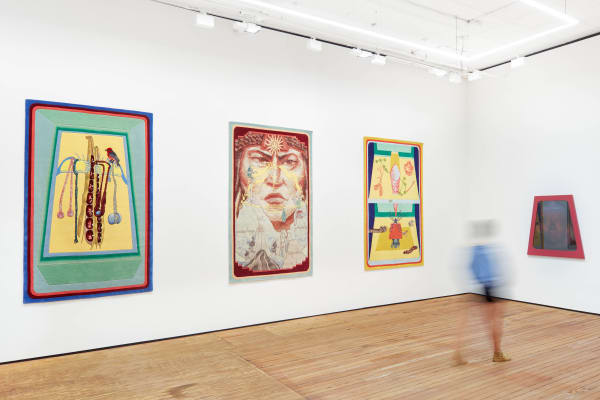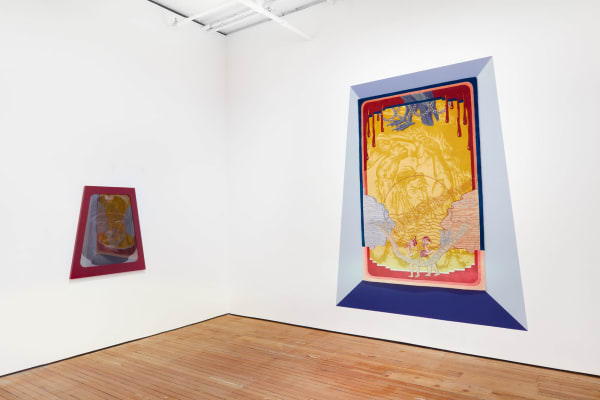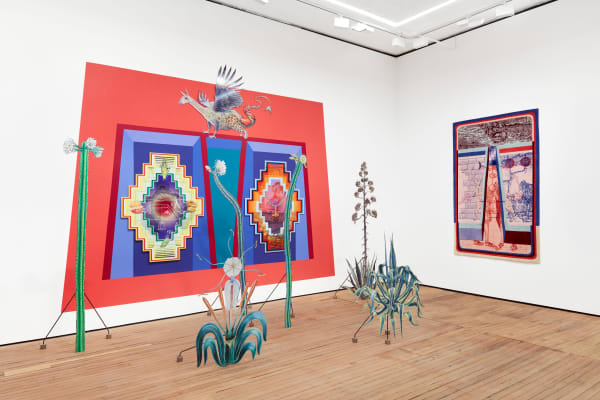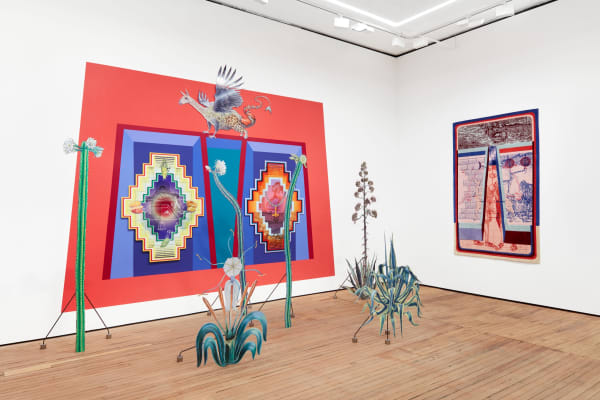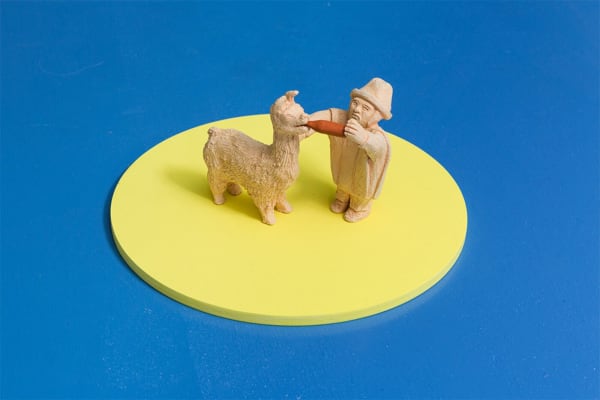Claudia Martínez Garay: Ghost Kingdom
GRIMM is pleased to present Ghost Kingdom, an exhibition by Claudia Martínez Garay, on view from September 9 to October 15, 2022. A walk-through with Marcela Guerrero, Assistant Curator at the Whitney Museum of American Art, will take place in the gallery on Saturday, September 10th at 11:30. (RSVP: info@grimmgallery.com)
In Ghost Kingdom, Claudia Martínez Garay continues her ongoing investigative practice of history and memory in her home country of Peru concerning racism, war, social prosecution, and the legacies of colonialism toward the Andean people. Martínez Garay creates a body of work that articulates a powerful auto-narrative of a culture constantly mediating its interrupted pasts.
In Preguntitas a la Tierra (Little questions to the Land (Ground, Soil, Dirt), pamphlets distributed as propaganda between the 1970’s to the 1990’s in Peru and its surrounding region are appropriated and reconfigured. Martínez Garay interrogates this circulation of media by collaging these signs in juxtaposition to each other, forming a landscape that re-appropriates their methods of signification to describe many commonalities felt throughout Latin America, left in the aftermath of colonialism, religious upheaval, dictatorship, guerrilla warfare, and civil war.
In her recent Pacha works, symbols of Andean cosmology, native cultures of Peru, ethnographic journals, western chronicles of the land, and personal history are physically woven together. These multi-temporal visual gatherings -at times deeply introspective, at others anthropological- are charged with symbolism. This ongoing series reflects on time and its passing, complicating our understanding of what constitutes a historic document, and seeks to defy linear time. For the artist, these seven new textile works animate flashbacks through time, where the gaps in personal and collective history are often masked in the long durée of political upheaval.
In a series of new sculptures, academic drawings of native flora from the South American region are printed on aluminum panels and placed throughout the gallery. Transformed out of their anthropological context, these works form an uncanny terrain where their flat imagery emphasizes the alien means of their documentation and questions the history of categorization, which affects our ideas of their natural belonging.
GRIMM will also present Ayataki (2022), a new animated video and surround sound installation by the artist, commissioned and produced by Artpace, San Antonio, and the Denver Art Museum. The video-sound installation recently debuted in Who tells a tale adds a tail: Latin America and contemporary art, currently on view at Denver Art Museum. Through visuals and a collaged original score, reinterpreted with a synthesizer by the artist, Peruvian Andean folkloric music is intertwined with Quechua church melodies, radio transmissions, Spanish dialogues, sorrowful voices, pan-flutes, raging guitars, and radio commercial propaganda to relay a tale of forced displacement due to violence and war. The radio tower, the bomb cars, and burned rural houses- often targeted by the terrorist group Shinning Path during the internal war in Peru have become symbols of terror, loss, and despair of that time. This work as a whole is a lamentation on the Andean landscape. Social issues and historical events are presented in a nonlinear narrative, and the mixed poetic and formal composition of sound constructs a solemn funeral cadence which sonically reflects a mourning for those who did not survive the war.
Throughout all of Ghost Kingdom Martínez Garay shows that recorded history and media, although divisive, can -and has been- reclaimed by the people of Peru and its surrounding regions. Claudia Martínez Garay's striking installation practice, brilliant use of color, and varied configurations of scale and material reminds us of the importance of collective mythologies in reclaiming symbols of the past through alternative methods of storytelling practiced throughout South American communities to challenge hegemonic colonial narratives and propose alternative futures.
Claudia Martínez Garay (b. 1983 in Ayacucho, Peru) studied printmaking at the Pontificia Universidad Católica of Peru (PE) and was a resident at the Rijksakademie van Beeldende Kunsten in Amsterdam (NL) 2016 and 2017. Recent solo exhibitions includeCaminos de Liberación, GRIMM, Amsterdam (NL) in 2021 and Ten Thousand Things, Sifang Art Museum, Nanjing (CN) in 2020. Selected group exhibitions include, Who Tells a Tale Adds a Tail: Latin America and Contemporary Art, Denver Art Museum, CO (US) in 2022; consume by, Museum Arnhem, Arnhem (NL) in 2022; No Linear Fucking Time, B.A.K., basis voor actuele kunst, Utrecht (NL) in 2021; All Eyes | We are the collection, Akzo Nobel Art Foundation, Amsterdam (NL) in 2021; Plural Domains, Harn Museum of Art, Gainesville, FL (US) in 2021; 1 Million Roses for Angela Davis, Kunsthalle im Lipsiusbau, Dresden (DE) in 2020; The Faculty of Sensing: Anton Wilhelm Amo, Kunstverein, Braunschweig and SAVVY Contemporary, Berlin (DE) in 2020; Imagined Communities, 21st Contemporary Art Biennial Sesc_Videobrasil, São Paulo (BR) in 2019; the 16th Istanbul Biennal titled The Seventh Continent, curated by Nicolas Bourriaud, Istanbul (TR) in 2019; Immortality, 5th Ural Industrial Biennial of Contemporary Art, curated by Xiaoyu Weng, Ekaterinburg (RU) in 2019; Diplomacy at Yeh Art Gallery, St. John’s University, Queens, NY (US) in 2019; Taming Y/Our Passion, Aichi Triennial, Aichi (JP) in 2019; Pro-Regress, curated by Cuauhtémoc Medina, the 12th Shanghai Biennial, Shanghai (CN) in 2018; and Triennial: Songs for Sabotage, New Museum, New York, NY (US) in 2018.
Her work can be found in the collections of Museum Arnhem (NL); Sifang Art Museum, Nanjing (CN); Akzo Nobel Art Foundation, Amsterdam (NL); AMC Art Collection, Amsterdam (NL); Fundación Studie e Richerche Benetton, Treviso (IT); Central Reserve Bank of Peru, Lima (PE); CIFO Cisnero Fontanals Art Foundation, Miami, FL (US); KADIST Collection (FR); KPMG Art Collection, Amsterdam (NL); Lima Art Museum (MALI) (PE); LOOP Collection lent to MACBA Museu d’Art Contemporani, Barcelona (ES); Micromuseo al fondo hay sitio, Lima (PE); Museu Olho Latino, Atibaia (BR), among others.


